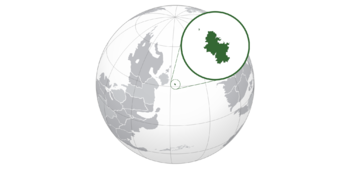Kernev
Principality of Kernev Pennsevigeth Kernev | |
|---|---|
Motto: Onen hag oll One and all | |
Anthem: Kernev Ow Dhre (Jackian: "Kernev my home") | |
 | |
| Capital | Lannstevan |
| Largest | Truru |
| Official languages | Kernevic Eusazy |
| Recognised regional languages | Kernevic Jackian |
| Religion | Clovity |
| Demonym(s) | Kernevic Kernowek Kernevek |
| Government | Unitary parliamentary constitutional monarchy |
• Monarch | Corentyn Arthyen |
| Morwenna Pascoe | |
| Legislature | Senedh Kernev |
| Establishment | |
• Settlement | 22 AD |
| Area | |
• Total | 5,177.92 km2 (1,999.21 sq mi) |
| Population | |
• 2022 estimate | 596,277 |
• 2015 census | 591,631 |
| GDP (nominal) | 2022 estimate |
• Total | ₵19.45 billion |
• Per capita | ₵32,621 |
| Currency | Kernevic Tokyn (KTK) |
| Time zone | AMT+14 (AOL) |
| Date format | dd-mm-yyyy (CE) |
| Driving side | left |
| Calling code | +404 |
| ISO 3166 code | KNV |
| Internet TLD | .knv |
Kernev, officially the Principality of Kernev (Kernevic: Pennsevigeth Kernev), is an island country in the northern Kivu Ocean. Consisting of the main island, and a number of smaller islands, it is 512 kilometres (318 mi) from the Island of Môn and 1,226 kilometres (762 mi) from mainland Ostlandet. The island has been considered as part of the Arcraihb Isles, but more recently is considered a separate geographic entity. Its capital is the town of Lannstevan, though the largest town is Truru. There are no cities in Kernev.
The Isle of Kernev was uninhabited until 22 AD, when the first settlers from modern-day Paleocacher, arrived. Though the voyage to the isle from Ostlandet was highly perilous, the settlers survived owing in large part to the highly fertile soils of Kernev. The isle became well-established as a centre of mining within the 1st century AD, producing large quantities of tin and copper.
Although most tin mines closed in the mid-20th century, the discovery of Lithium deposits in the east of the isle has resulted in proposals to reopen former mines across the isle. Mining still forms a significant part of the Kernevic economy, however since 1932, the largest sector of the Kernevic economy has been tourism.
The Kernevic language is endemic to Kernev, and is linguistically isolated from its nearest language, Eusazy, which is co-official for international affairs in Kernev. Kernevic Jackian is a recognised regional language, owing to Kivuan colonisation in X, most Jackian speakers are concentrated in the east of the country. Jackian in Kernev is characterised by differing spelling conventions, a prominent rhotic tendency and a number of influences from native Kernevek.
Kernev is a member of the Terraconserva Council of Nations and the Regional Organisation of the Kivu Ocean, and is an observer state of the Ostlandet Union. It is a signatory to a number of international agreements, and has bilateral agreements with the Ostlandet Union, the Alliance of Central Ecrosian States and EEFTA.
Etymology
The modern Jackian term Kernev is the endonym of Kernev, rooting from the Paleo-Gallaetic karnu (meaning horn or headland), the root of the Eusazy word ceann meaning 'head'. The name is believed to refer to the headland in Penntyr where the earliest record of human settlement has been found.
History
The earliest evidence of settlement of Kernev is in the first century AD. Archaeologists found burnt grains of domesticated barley and peat ash deposited in two phases, the prior was dated between the first and third centuries, the latter was dated between the fifth and sixth centuries.

